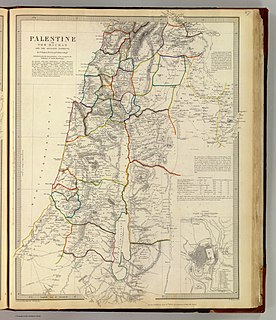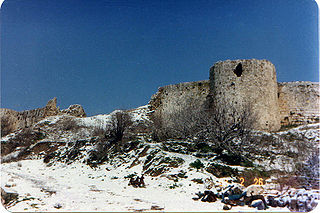Related Research Articles

Dayr al-Qassi or Deir el-Qasi,was a Palestinian Arab village located 26 km northeast of the city of Acre,which was depopulated during 1948 Arab-Israeli war.

Zahir al-Umar al-Zaydani,alternatively spelled Daher al-Omar or Dahir al-Umar was the autonomous Arab ruler of northern Palestine in the mid-18th century,while the region was part of the Ottoman Empire. For much of his reign,starting in the 1730s,his domain mainly consisted of the Galilee,with successive headquarters in Tiberias,Deir Hanna and finally Acre,in 1750. He fortified Acre,and the city became the center of the cotton trade between Palestine and Europe. In the mid-1760s,he reestablished the port town of Haifa nearby.

The Eyalet of Sidon was an eyalet of the Ottoman Empire. In the 19th century,the eyalet extended from the border with Egypt to the Bay of Kisrawan,including parts of modern Israel and Lebanon.

Ahmad Pasha al-Jazzar was the Acre-based Ottoman governor of Sidon Eyalet from 1776 until his death in 1804 and the simultaneous governor of Damascus Eyalet in 1785–1786,1790–1795,1798–1799,and 1803–1804. A Bosnian of obscure origins,he began his military career in Egypt in the service of various mamluk officials,eventually becoming a chief enforcer and assassin for Ali Bey al-Kabir,Egypt's practical ruler. He gained the epithet of al-Jazzar for his deadly ambush on a group of Bedouin tribesmen in retaliation for the death of his master in a Bedouin raid. Al-Jazzar fell out with Ali Bey in 1768 after refusing to take part in the assassination of one of his former masters. He ultimately fled to Syria,where he was tasked with defending Beirut from a joint assault by the Russian Navy and Zahir al-Umar,the Acre-based ruler of northern Palestine. He eventually surrendered and entered Zahir's service before defecting from him and fleeing with stolen tax money.

The Shihab dynasty was an Arab family whose members served as the paramount tax farmers and local chiefs of Mount Lebanon from the early 18th to mid-19th century,during Ottoman rule. Their reign began in 1697 after the death of the last Ma'nid chief. The family centralized control over Mount Lebanon,destroying the feudal power of the mostly Druze lords and cultivating the Maronite clergy as an alternative power base of the emirate. The Shihab family allied with Muhammad Ali of Egypt during his occupation of Syria,but was deposed in 1840 when the Egyptians were driven out by an Ottoman-European alliance,leading soon after to the dissolution of the Shihab emirate. Despite losing territorial control,the family remains influential in modern Lebanon,with some members having reached high political office.
Sulayman Pasha al-Azm was the governor of Sidon Eyalet (1727–33),Damascus Eyalet,and Egypt Eyalet (1739–40) under the Ottoman Empire. He belonged to the prominent Al-Azm family and was the uncle of As'ad Pasha al-Azm,who succeeded him as governor of Damascus,and Sa'deddin Pasha al-Azm,who also served as governor of Egypt.
Uthman Pasha al-Kurji,was the Ottoman governor (wali) of Damascus Eyalet between 1760 and 1771.
Al-Zayadina were an Arab clan based in the Galilee. They were best known after one of their sheikhs (chiefs) Zahir al-Umar,who,through his tax farms,economic monopolies,popular support,and military strength ruled a semi-autonomous sheikhdom in northern Palestine and adjacent regions in the 18th century.
Nasif ibn al-Nassar al-Wa'ili was the most powerful sheikh of the rural Shia Muslim (Matawilah) tribes of Jabal Amil in the mid-18th century. He was based in the town of Tebnine and was head of the Ali al-Saghir clan. Under his leadership,the Jabal Amil prospered,due largely to the revenues from dyed cotton cloth exports to European merchants.
Yusuf Shihab (1748–1790) was the autonomous emir of Mount Lebanon between 1770 and 1789. He was the fifth consecutive member of the Shihab dynasty to govern Mount Lebanon.
Husayn Pasha ibn Makki served as the Ottoman wali of Damascus (1757) and Marash (1762),and the sanjak-bey of his native Gaza (1763–1765).
In the Battle of Lake Huleh on 2 September 1771,the rebel forces of Zahir al-Umar and Nasif al-Nassar routed the army of Uthman Pasha al-Kurji,the Ottoman governor of Damascus,at Lake Huleh in the eastern Galilee. Most of Uthman Pasha's 10,000-strong army drowned in the Jordan River as they attempted to flee Zahir's forces commanded by his son Ali al-Zahir. According to historian William Harris,the battle has been "mythologized in local historiography and poetry". Nonetheless,no official account of the battle by the Ottomans was recorded.

Safed Sanjak was a sanjak (district) of Damascus Eyalet in 1517–1660,after which it became part of the Sidon Eyalet. The sanjak was centered in Safed and spanned the Galilee,Jabal Amil and the coastal cities of Acre and Tyre. The city of Safed was made up of Muslim and Jewish townspeople,while the rest of the sanjak was populated by Sunni Muslims,Jewish peasants,Bedouin tribesmen,Shia Muslims and Druze peasants.
Mansur Bey ibn Furaykh was Emir of the Biqa'a,Safad and Ajlun districts in the late 16th century during Ottoman rule. The Ottomans granted Mansur this large power base to enable him to check the growing power of rebellious Lebanese clans,namely the Ma'an and Harfush. However,complaints were lodged against him alleging that he oppressed his subjects,and killed and robbed wealthy Muslim pilgrims during his service as amir al-hajj. Mansur also failed to pay the Ottoman authorities the taxes they were due from his sanjaks. Because of these actions,Mansur was arrested and executed.
Mansur Shihab was the Emir of Mount Lebanon between 1754 and 1770. He and his brother Ahmad took the reins of power from their ailing brother Mulhim Shihab and ruled jointly until Mansur became the sole emir after winning a power struggle with Ahmad in 1763. Mansur aligned himself with Zahir al-Umar and Ali Bey,the autonomous rulers of Galilee and Egypt,respectively,in their rebellion against the Ottomans. Mansur was subsequently forced by the Druze sheikhs of Mount Lebanon to step down in favor his nephew Yusuf Shihab after Zahir and Ali Bey were defeated in 1770.
Arslan Mehmed Mataraci Pasha,also Arslan Muhammad Pasha ibn al-Mataraji,was the wali of Tripoli in 1694–1700 and 1702–1703,Damascus in 1701 and Sidon in 1703–1704.
The Turabay dynasty was the preeminent household of the Bedouin Banu Haritha tribe in northern Palestine whose chiefs traditionally served as the multazims and sanjak-beys of Lajjun Sanjak during Ottoman rule in the 16th–17th centuries. The sanjak spanned the towns of Lajjun,Jenin,Haifa and Atlit and the surrounding countryside. The progenitors of the family had served as chiefs of Marj Bani Amir under the Mamluks in the late 15th century.

El-Assaad or Al As'ad is a feudal political family/clan originally from Najd and a main branch of the anza tribe. Unrelated to Syrian or Palestinian Al-Assads,El-Assaad dynasty that ruled most of South Lebanon for three centuries and whose lineage defended fellow denizens of history's Jabal Amel principality –today southern Lebanon –for 36 generations,Balqa in Jordan,Nablus in Palestine,and Homs in Syria governed by Ottoman rule between generations throughout the Arab caliphate by Sheikh al Mashayekh Nasif Al-Nassar ibn Al-Waeli,Ottoman conquest under Shbib Pasha El Assaad,Ali Bek El Assaad ruler of Belad Bechara,Ali Nassrat Bek. Advisor of the Court and a Superior in the Ministry of Foreign affairs in the Ottoman Empire,Moustafa Nassar Bek El Assaad Supreme Court President of Lebanon and colonial French administration by Hassib Bek—also supreme court Judge and grand speaker at halls across the Levant. El-Assaads are considered now "Bakaweit",and are considered princes or heirs to the family's dynasty to some.
The sieges of Tiberias occurred in late 1742 and the summer of 1743 when the Ottoman governor of Damascus,Sulayman Pasha al-Azm,twice attempted and failed to eliminate the increasingly powerful,Tiberias-based multazim,Zahir al-Umar,and destroy his fortifications.
Kaplan Mataraci Pasha was the Ottoman governor of Sidon in 1698–1703.